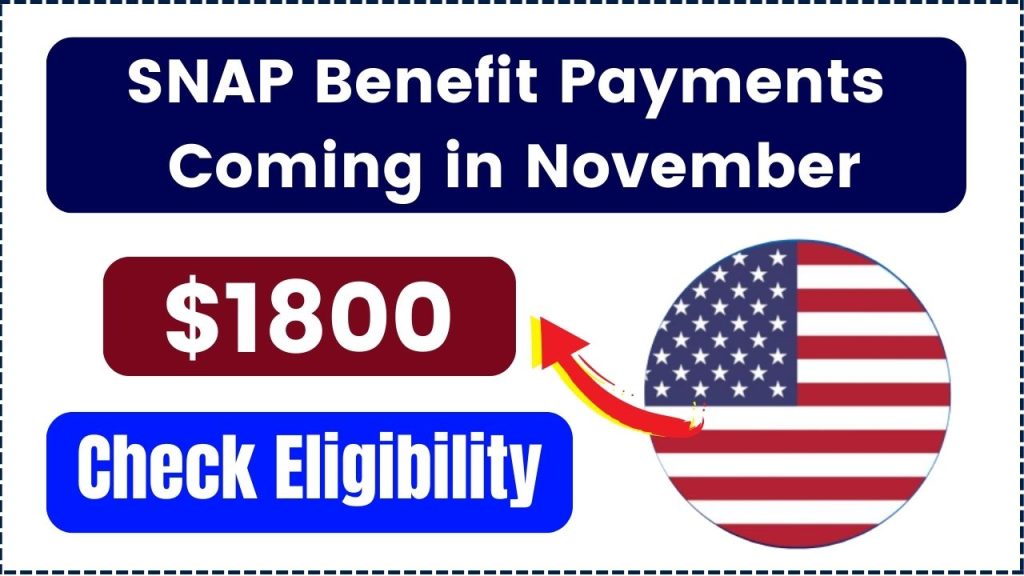$1800 SNAP Benefit Payments Coming in November: The Supplemental Nutrition Assistance Program (SNAP) provides essential aid to millions of Americans, helping low-income families put food on the table. This November, some households could see SNAP benefits reaching up to $1,800. With recent updates to benefit amounts and adjustments in eligibility criteria, it’s crucial for potential recipients to understand how SNAP works, their eligibility, and how and when these benefits will be loaded onto Electronic Benefit Transfer (EBT) cards.

Here’s a breakdown of what you need to know to see if you qualify for these benefits, how they are distributed, and important details to ensure you don’t miss out on any payments this month.
$1800 SNAP Benefit Payments Coming in November
| Details | Key Information |
|---|---|
| Maximum SNAP Benefit for 8+ People | Households of nine or more can receive up to $1,800 per month. |
| Eligibility Requirements | Gross income at or below 130% of poverty line; net income at or below 100%. |
| EBT Card Loading Schedule | Varies by state; often based on case number or last name. |
| Recent Updates | Annual Cost-of-Living Adjustment (COLA) as of October 1, 2024. |
| Resource Links | SNAP Official Site for details and state-specific benefits and schedules. |
SNAP benefits provide vital support to low-income families and individuals across the United States. This November, households with higher needs might see benefits reaching up to $1,800 due to household size and specific eligibility factors. By understanding the eligibility criteria, staying informed about EBT card loading schedules, and keeping up with recent SNAP policy updates, eligible households can maximize their benefits and maintain food security.
What is SNAP, and How Does It Work?
The Supplemental Nutrition Assistance Program (SNAP), formerly known as Food Stamps, is a federally funded program aimed at supporting low-income individuals and families by providing monthly benefits to purchase food. These benefits are distributed via EBT cards, which function like debit cards and can be used at authorized retailers to purchase eligible food items.
Benefits are calculated based on household size, income, and various expenses, with specific limits set for each factor. As of recent updates, the program has adjusted benefit levels to align with cost-of-living increases, ensuring that households receive adequate support in light of rising food prices.
The Importance of SNAP for Food Security
SNAP is a critical lifeline for millions of Americans, helping address food insecurity by providing consistent monthly support. Food insecurity affects nearly 34 million people, including over 9 million children, in the United States, according to the USDA. SNAP benefits allow recipients to purchase nutritious food, supporting health and well-being, especially for households that would otherwise struggle to afford healthy meals. By keeping families nourished, SNAP also contributes to improved educational outcomes for children, better productivity for working adults, and reduced healthcare costs.
For more information on food security statistics, refer to the USDA Food Security Report.
Eligibility Criteria for SNAP Benefits
Income and Asset Limits
To qualify for SNAP benefits, households must meet specific income limits:
- Gross Monthly Income: Generally, households need to have a gross monthly income at or below 130% of the federal poverty line. For example, in 2024, this limit is approximately $1,580 for a single-person household or $3,250 for a family of four.
- Net Monthly Income: After deductions, household income should be at or below 100% of the federal poverty line. Deductions include allowances for shelter costs, child support payments, and medical expenses, which can help households meet the net income test.
- Asset Limit: In some states, households must also have assets below a certain limit, typically $2,750 or $4,250 if a member is 60 or older.
For more detailed eligibility guidelines, you can visit the official SNAP Eligibility site.
Allowable Deductions That Affect SNAP Eligibility
Understanding the deductions allowed by SNAP is crucial because these deductions help lower a household’s net income, potentially increasing their benefit amount. Some common deductions include:
- Standard Deduction: Every household receives a base deduction, varying slightly by state.
- Shelter Deduction: If a household pays over half of its income on rent or mortgage and utilities, it may qualify for a shelter deduction.
- Child Support: Households making child support payments can deduct these expenses from their gross income.
- Medical Expenses: For elderly or disabled household members, medical costs over $35 a month can be deducted.
These deductions help determine eligibility by making SNAP accessible to households that may have higher expenses. You can see a list of allowable deductions on the USDA SNAP Deductions page.
SNAP Benefit Levels: How Much Could You Receive?
As of October 1, 2024, the maximum monthly SNAP benefits are:
| Household Size | Maximum Monthly Benefit |
|---|---|
| 1 | $292 |
| 2 | $536 |
| 3 | $768 |
| 4 | $975 |
| 5 | $1,158 |
| 6 | $1,390 |
| 7 | $1,536 |
| 8 | $1,756 |
| Each Additional | +$220 |
To receive $1,800 or more in benefits, a household must typically consist of nine or more members. These benefits cover basic food necessities and ensure that households can afford nutritious meals each month.
How Are SNAP Benefits Distributed? Understanding EBT Card Loading Days
EBT Card Distribution Basics
SNAP benefits are distributed each month via Electronic Benefit Transfer (EBT) cards, which function similarly to debit cards. EBT cards are loaded monthly based on a state-specific schedule that considers factors such as the last digit of your case number or the first letter of your last name.
- State Variations: States determine their SNAP benefit loading schedules. For example, in Florida, benefits are distributed from the 1st to the 28th, based on the 9th and 8th digits of a case number. Other states like California issue benefits within the first ten days of the month, while Texas follows a staggered schedule from the 1st to the 15th.
- Checking Your EBT Balance: You can check your balance by calling the number on the back of your EBT card, logging into your state’s EBT portal, or using an authorized mobile app for SNAP benefits tracking.
To find the exact EBT card loading schedule for your state, refer to resources like this GOBankingRates guide which outlines loading dates for all 50 states.
Recent Changes and Updates to SNAP Benefits
Cost-of-Living Adjustments (COLA)
To help families keep up with rising costs, SNAP benefits are adjusted annually based on the Cost-of-Living Adjustment (COLA). As of October 1, 2024, these adjustments have increased the maximum benefit amounts for most recipients, providing additional support to cover higher food prices.
New Work Requirements for Certain Recipients
New regulations introduce work requirements for specific able-bodied adults without dependents (ABAWD), particularly those aged 52 to 54. These individuals must meet certain work criteria—usually 20 hours per week—in order to continue receiving benefits. For additional information, visit the USDA SNAP Policy Updates.
Social Security Payment Dates coming in November 2024 – Check SSI, SSDI, VA Schedule
VA Disability Pay Chart November 2024: Veterans Disability Compensation Rates
US Interest Rate 2024 Changes : Know Amount Of Change & Rates
Practical Steps to Apply for SNAP Benefits
- Check Your Eligibility: Use an online pre-screening tool available through your state’s SNAP website or call your local SNAP office.
- Gather Required Documents: These typically include proof of identity, income, expenses, and residency.
- Submit Your Application: Applications can be submitted online, by mail, or in person at a local SNAP office.
- Complete an Interview: Most applicants will need to complete a short eligibility interview, which may be conducted by phone or in person.
- Receive Your EBT Card: Once approved, you’ll receive your EBT card in the mail. Remember to activate it upon arrival.
For additional guidance, visit the official SNAP Benefits Application Guide.
Additional Resources
Here are some useful resources for managing SNAP benefits and exploring other food assistance options:
- MyPlate.gov: Offers nutrition guidance and meal planning tools.
- Feeding America: Information on local food banks and meal programs.
- Budgeting Tools: Helpful resources from the Consumer Financial Protection Bureau to assist with budgeting on a limited income.
FAQs On $1800 SNAP Benefit Payments Coming in November
How do I know if I’m eligible for SNAP?
Eligibility is based on household income,
assets, and certain deductions. Check your state’s SNAP website or use the USDA’s Eligibility Pre-Screener.
When will my EBT card be loaded?
Loading dates depend on your state and are usually tied to your case number or last name. For a full schedule, check with your local SNAP office.
Can I use SNAP benefits to buy prepared foods?
In most cases, SNAP benefits cannot be used to buy prepared foods. However, some states have Restaurant Meals Programs that allow qualifying SNAP recipients to purchase prepared meals from participating restaurants.
What if I lose my EBT card?
If you lose your EBT card, contact your state’s EBT customer service line immediately to report the loss and request a replacement card.
Will SNAP benefits increase in the future?
SNAP benefits are adjusted annually for cost-of-living changes. You can expect these adjustments each October.

